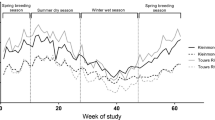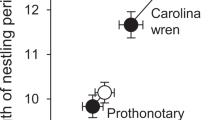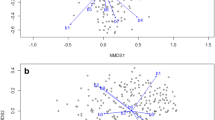Abstract
The importance of genotype by temperature interactions contributing to individual differences in nesting behavior has been demonstrated using two inbred strains ofMus musculus. Exposure to low ambient temperature increased amounts of cotton used by both the high-nesting (BALB/cJ) and low-nesting (C57BL/6J) strains. The larger total nesting scores of BALB/cJ mice compared to those of C57BL/6J mice resulted from differential increases, depending on temperature, in the amount of cotton used across days, so that the strain differences were greater in both rate of increase and total cotton used for animals tested at 5°C than for those tested at 26°C. The correlation between per gram food consumption and weight of nests was large and negative for animals tested at 5°C, and low for animals tested at 26°C, indicating a metabolic advantage in the cold for animals which built large nests. It is suggested that demonstration of a genotype-environment interaction contributing to differences among natural populations for a specific phenotype provides evidence that the character has been modified by selection acting through the environmental variable being studied.
Similar content being viewed by others
References
Barnett, S. A. (1961). Some effects of breeding mice for many generations in a cold environment.Proc. Roy. Soc. 155: 115–135.
Barnett, S. A., and Coleman, E. M. (1960). “Heterosis” in F1 mice in a cold environment.Genet. Res. Camb. 1: 25–38.
Barnett, S. A., and Manly, B. M. (1956). Reproduction and growth of mice of three strains, after transfer to −3°C.J. Exptl. Biol. 33: 325–329.
Bruell, J. H. (1967). Behavioral heterosis. In Hirsch, J. (ed.),Behavior-Genetic Analysis, McGraw-Hill, New York, pp. 270–286.
DeFries, J. C. (1964). Prenatal maternal stress in mice: Differential effects on behavior.J. Hered. 55: 289–295.
DeFries, J. C. (1967). Quantitative genetics and behavior: overview and perspective. In Hirsch, J. (ed.),Behavior-Genetic Analysis, McGraw-Hill, New York, pp. 322–339.
DeFries, J. C., Weir, M. W., and Hegmann, J. P. (1967). Differential effects of prenatal maternal stress on offspring behavior in mice as a function of genotype and stress.J. Comp. Physiol. Psychol. 63: 332–334.
Falconer, D. S. (1960).Introduction to Quantitative Genetics, Ronald Press, New York, 365 pp.
Harvey, W. R. (1960).Least Squares Analysis of Data with Unequal Subclass Numbers, Publ. No. ARS-20-8, Department of Agriculture, Washington, D.C.
Hawkins, J. D. (1970). Single gene substitutions and behavior. In Lindzey, G., and Thiessen, D. D. (eds.),Contributions to Behavior-Genetic Analysis: The Mouse as a Prototype, Appleton-Century-Crofts, New York, pp. 139–159.
King, J. A., Maas, D., and Weisman, R. G. (1964). Geographic variation in nest size among species ofPeromyscus.Evolution 18: 230–234.
Layne, J. N. (1969). Nest-building behavior in three species of deer mice,Peromyscus. Behavior 35: 288–303.
Lee, C. T., and Wong, P. T. P. (1970). Temperature effect and strain differences in the nest-building behavior of inbred mice.Psychon. Sci. 20: 9–10.
Lynch, C. B., and Hegmann, J. P. (1972). Genetic differences influencing behavioral temperature regulation in small mammals. I. Nesting byMus musculus.Behav. Genet. 2: 43–53.
Manosevitz, M., and Lindzey, G. (1970). Genetic variation and hoarding. In Lindzey, G., Thiessen, D. D. (eds.),Contributions to Behavior-Genetic Analysis: The Mouse as a Prototype, Appleton-Century-Crofts, New York, pp. 91–113.
Muul, I. (1968). Behavioral and physiological influences on the distribution of the flying squirrel,Glaucomys volans. Misc. Publ. Mus. Zool. Univ. Mich. 134: 66 pp.
Pearson, O. P. (1960). The oxygen consumption and bioenergetics of the harvest mouse.Physiol. Zool. 33: 153–160.
Roberts, R. C. (1967). Some concepts and methods in quantitative genetics. In Hirsch, J. (ed.),Behavior-Genetic Analysis, McGraw-Hill, New York, pp. 214–257.
Author information
Authors and Affiliations
Additional information
This investigation was supported in part by grant No. NS09536 from the National Institutes of Health.
Rights and permissions
About this article
Cite this article
Lynch, C.B., Hegmann, J.P. Genetic differences influencing behavioral temperature regulation in small mammals. II. Genotype-environment interactions. Behav Genet 3, 145–154 (1973). https://doi.org/10.1007/BF01067654
Received:
Accepted:
Issue Date:
DOI: https://doi.org/10.1007/BF01067654




